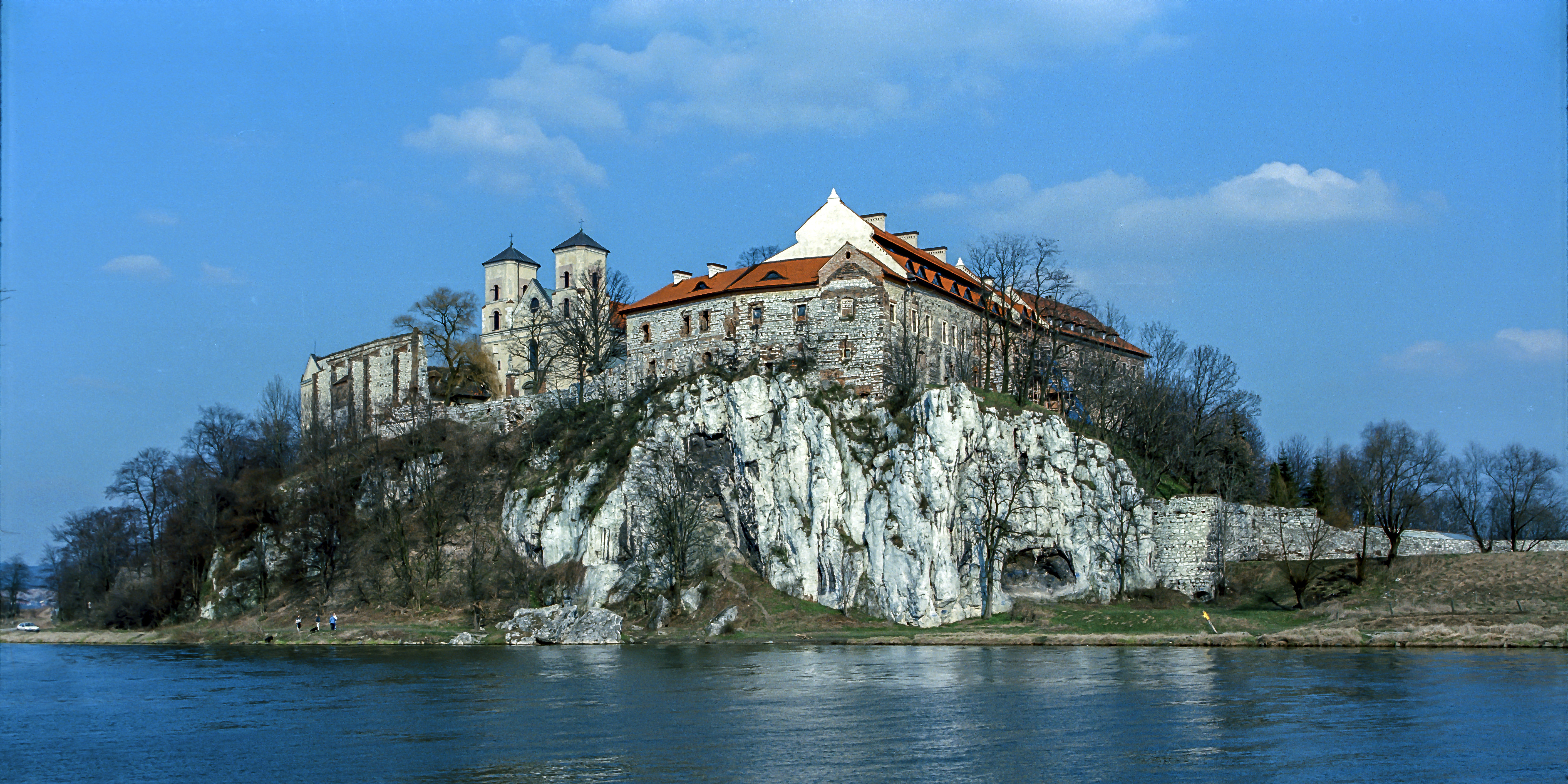 Zbaczając tuż za mostem Dębnickim z najruchliwszej chyba trasy miasta w prawo, dociera się nagle na Rynek Dębnicki – senny rynek małego miasteczka. Autobusem np. #112 w ciągu kilkunastu minut (12 km od Krakowa) można się stamtąd przenieść w sam środek mrocznego średniowiecza, takiego, jakie – przy bujnej wyobraźni może przyjść do głowy takie porównanie – Umberto Eco ukazał w Imieniu Róży. Każdy pasażer autobusu powie, gdzie wysiąść, aby dostać się do opactwa -jednego z trzech klasztorów benedyktyńskich w Polsce. Droga w prawo, która mija cmentarz z jednej, a wiekowe zabudowania gospodarcze z drugiej strony, podchodzi na opadające urwistymi skałami wprost ku Wiśle wzgórze. Od niepamiętnych czasów było ono wykorzystywane jako warownia przez różne prehistoryczne ludy (kultury przeworskiej, celtyckiej, tynieckiej). Od lat 40. XI w. nieprzerwanie pracują i wielbią tam Boga mnisi w czarnych habitach. Ich credo to: Ora et labora – módl się i pracuj.
Zbaczając tuż za mostem Dębnickim z najruchliwszej chyba trasy miasta w prawo, dociera się nagle na Rynek Dębnicki – senny rynek małego miasteczka. Autobusem np. #112 w ciągu kilkunastu minut (12 km od Krakowa) można się stamtąd przenieść w sam środek mrocznego średniowiecza, takiego, jakie – przy bujnej wyobraźni może przyjść do głowy takie porównanie – Umberto Eco ukazał w Imieniu Róży. Każdy pasażer autobusu powie, gdzie wysiąść, aby dostać się do opactwa -jednego z trzech klasztorów benedyktyńskich w Polsce. Droga w prawo, która mija cmentarz z jednej, a wiekowe zabudowania gospodarcze z drugiej strony, podchodzi na opadające urwistymi skałami wprost ku Wiśle wzgórze. Od niepamiętnych czasów było ono wykorzystywane jako warownia przez różne prehistoryczne ludy (kultury przeworskiej, celtyckiej, tynieckiej). Od lat 40. XI w. nieprzerwanie pracują i wielbią tam Boga mnisi w czarnych habitach. Ich credo to: Ora et labora – módl się i pracuj.
Do opactwa wchodzi się przez potężną bramę. Przez ciasny dziedzińczyk i drugą bramę można wejść na szczyt wzgórza, z którego roztacza się widok na starorzecze Wisły. Niegdyś potężne opactwo zbudowane w XI w. w stylu romańskim, wielokrotnie przebudowywane, ostateczny kształt uzyskało w epoce baroku, tak więc z barokowych murów tylko miejscami (na krużganku) wyzierają kamienne, romańskie fragmenty. Opactwo, założone przez arcybiskupa Aarona, kształciło kadry dla organizującego się Kościoła polskiego. Później przez wiele setek lat znajdowali tu schronienie ludzie uciekający od zgiełku świata. Nawet świeccy, chcący zastanowić się nad sobą w sprzyjających kontemplacji warunkach, znajdowali w Tyńcu gościnę. Ten piękny zwyczaj przetrwał do dziś. W opactwie, gdzie panował od wieków kult Boga, powstał współczesny przekład Pisma św. Starego i Nowego Testamentu zwany Biblią Tysiąclecia.
Kościół Benedyktynów pod wezwaniem śś. Piotra i Pawła kryje pod posadzką prezbiterium archeologiczne relikty – fundamenty kościoła romańskiego z około XI w., niestety niedostępne dla zwiedzających. W latach 60. odkryto w tym miejscu wczesnoromańskie groby siedmiu Opatów z XI—XIII w. W jednym z grobów, tak zwanym Grobie Złotego Opata (ze względu na odkryte tam relikty ze złota) natrafiono na XI-wieczny kielich ze szczerego złota z patyną, używany jako kielich podróżny. Jest to drugi na świecie kielich podróżny pochodzący z tej epoki.
Rytuały modlitw nie zmieniły się prawie od 540 r., kiedy to Benedykt z Nursji ustanowił regułę dla pierwszego klasztoru benedyktynów na Monte Cassino. Codziennie o 15.00 (w niedziele i święta obowiązujące o 14.30) można wysłuchać i obejrzeć (a jest co) nieszpory śpiewane przez mnichów po łacinie. Można przyjechać do Tyńca przed świtem, wspiąć się obok cmentarza na wzgórze i o 6.00 wysłuchać jutrzni, czyli pierwszych modlitw porannych zgromadzenia. Czasami w letnie dni tak się składa, że pod koniec modłów wstaje słońce i rozświetla wielki witraż nad ołtarzem głównym. Widowisko o tyle piękne, że witraż wyobraża słońce, a dokładnie Jezusa Zbawiciela jako Słońce Wszechświata.
Niegdyś wioseczka, a obecnie należący do Dębników Tyniec żyje w jakimś nierzeczywistym, metafizycznym, lecz zauważalnym cieniu opactwa, o którym nie mówi się tu inaczej niż klasztor. A jednak jeszcze do niedawna można było, po przeżyciach duchowych, upić się siarczyście w nieistniejącej już karczmie Pod Lutym Turem – to właśnie w niej Zbyszko z Bogdańca ślubował dozgonną miłość Danusi Jurandównie.
Tyniec był zamieszkały jeszcze przed benedyktynami. Gdzieś na przestrzeni czasu pomiędzy VIII w. przed naszą erą a II w. naszej ery był osadą obronną. Opactwo powstało .dopiera’ w XI w. Pierwsi benedyktyni trafili do Krakowa z Nadrenii w 1044 r. staraniem Kazimierza Odnowiciela. Słynny biskup Aaron, wspominany przy okazji Wawelu, był ich Opatem, pełniącym jednocześnie funkcje biskupa Krakowa. Poza kulturotwórczą, opactwo tynieckie pełniło niezwykle ważną funkcje obronną dzięki dogodnemu położeniu na wapiennym, spadzistym wzgórzu, na strategicznym przełomie Wisły.
Jako twierdza Tyniec funkcjonował ładnych parę wieków, aż do drugiej połowy XVIII w., dopóki nie został zniszczony przez wojska rosyjskie. Opactwo zasłużyło się także jako gniazdo oporu konfederatów barskich, którzy wyruszyli stąd to pierwszej burzliwej nocy l podziemnym przejściem dostali się na zamek wawelski, odbijając go z rąk rosyjskich. W 1817 r. nastąpiła kasata zakonu. Benedyktyni opuścili Tyniec, a wiele z ich bezcennych ksiąg i dokumentów przewieziono do Lwowa, gdzie w XIX w. przepadły. Powrót benedyktynów nastąpił w 1939 r., zaś w 1969 r. klasztor na powrót stał się opactwem.